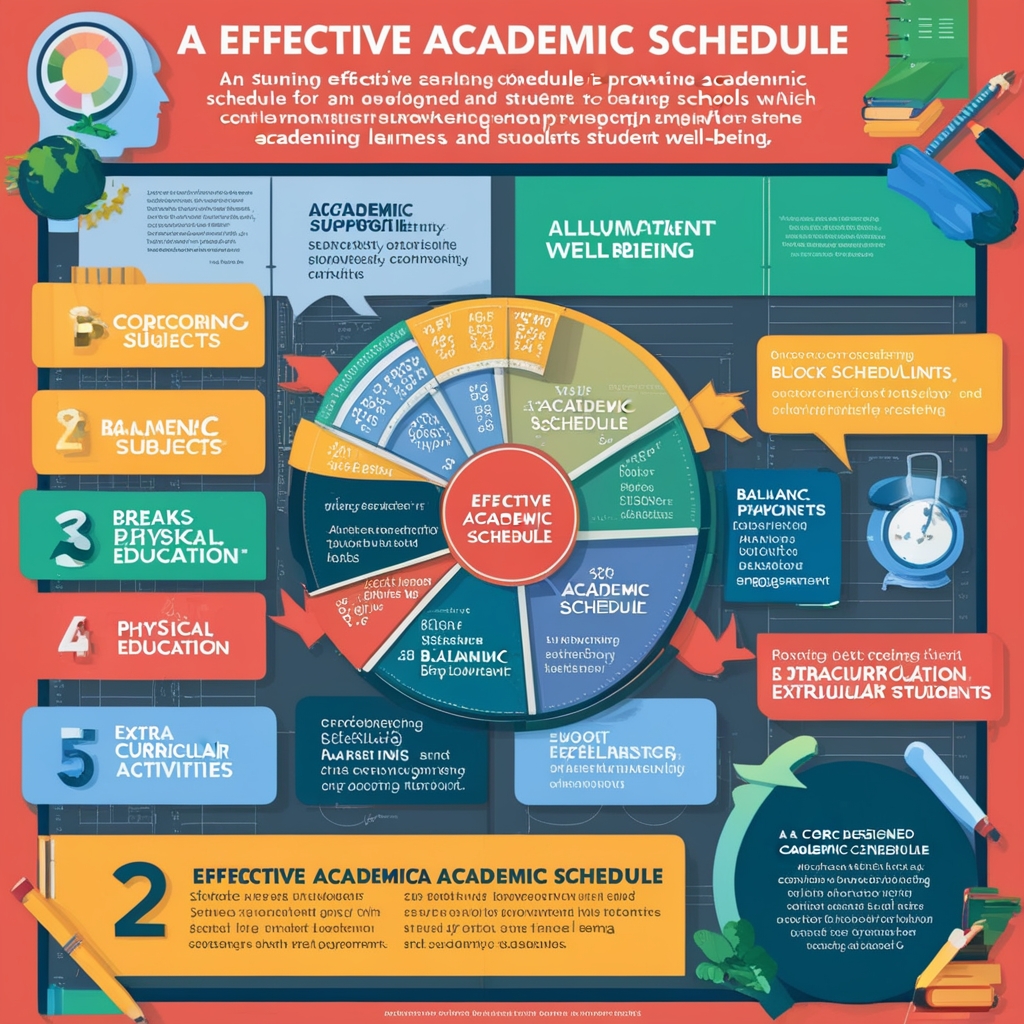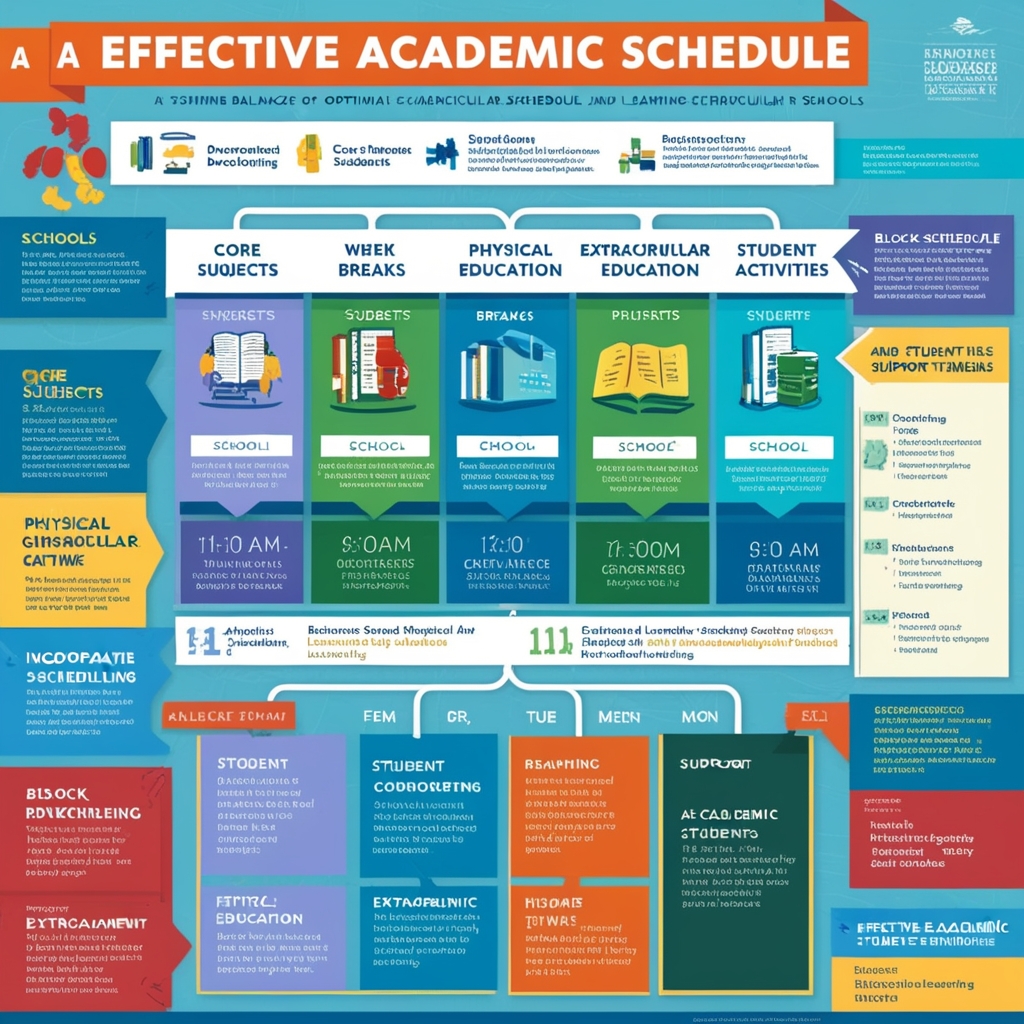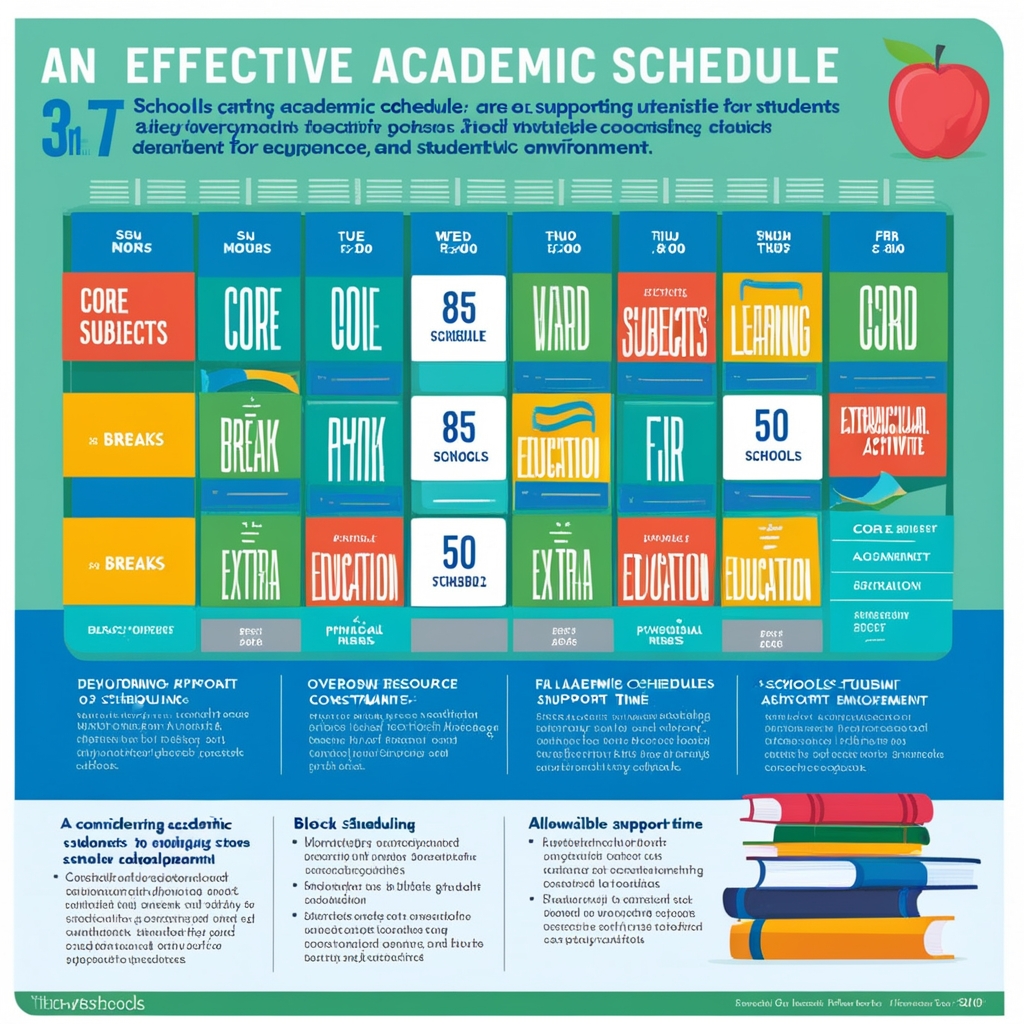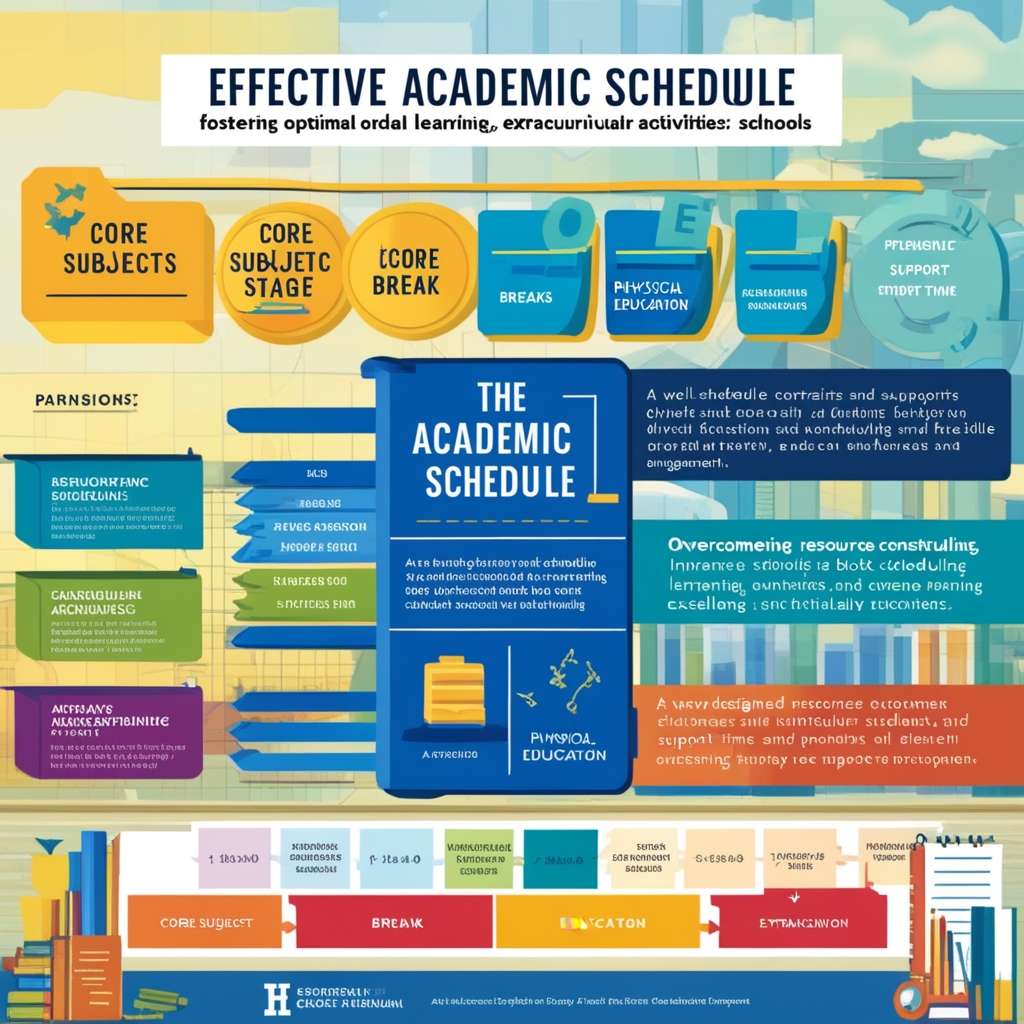Introduction
An Academic Schedules for Schools is more than just a timetable for classes; it is a carefully crafted plan that balances educational requirements, student well-being, and extracurricular activities. The design of an academic schedule can significantly impact students’ learning experiences, their ability to manage stress, and their overall development. This article explores the key elements of effective academic scheduling in schools, the benefits of well-designed schedules, and the challenges schools face in creating them.

Key Elements of Effective Academic Schedules
- Balanced Distribution of Subjects:
- Core Subjects: Ensure that core subjects such as math, science, language arts, and social studies are evenly distributed throughout the week to avoid cognitive overload on any given day.
- Variety and Flexibility: Include a mix of theoretical and practical subjects daily to maintain student engagement and interest.
- Incorporation of Breaks:
- Short Breaks: Integrate short breaks between classes to help students recharge and improve their focus.
- Lunch Periods: Ensure adequate time for lunch to allow students to relax, socialize, and refuel.
- Physical Education and Extracurricular Activities:
- Physical Education: Schedule regular physical education classes to promote physical health and reduce stress.
- Extracurriculars: Allocate time for extracurricular activities such as sports, arts, and clubs to support holistic development.
- Consideration of Age and Developmental Stages:
- Younger Students: For younger students, prioritize shorter class periods and more frequent breaks to align with their attention spans and energy levels.
- Older Students: For older students, consider longer class periods that allow for deeper engagement with the material.
- Block Scheduling:
- Advantages: Block scheduling, where classes meet for longer periods on fewer days, can provide opportunities for in-depth learning and hands-on activities.
- Challenges: Ensure that block scheduling does not lead to student fatigue or difficulty in retaining information between classes.
- Flexible Time for Student Support:
- Study Halls and Office Hours: Include study halls and teacher office hours in the schedule to offer students additional support and time for self-directed learning.

Benefits of Well-Designed Academic Schedules
- Enhanced Learning Outcomes: A well-structured academic schedule optimizes learning by aligning with students’ cognitive rhythms. Properly spaced classes and breaks improve focus, retention, and overall academic performance.
- Reduced Stress and Improved Well-being: Balanced schedules that include breaks, physical activity, and time for relaxation help reduce student stress and promote mental health. This holistic approach supports students’ emotional and psychological well-being.
- Increased Engagement and Motivation: A diverse schedule that incorporates a variety of subjects and activities keeps students engaged and motivated. When students have opportunities to explore their interests and talents, their overall enthusiasm for school increases.
- Development of Time Management Skills: Exposure to a well-organized schedule helps students develop essential time management skills. Learning to balance academic responsibilities with extracurricular activities and personal time is a crucial life skill.
Challenges in Creating Academic Schedules
- Resource Constraints: Schools often face limitations in terms of staff, classrooms, and facilities. These constraints can make it challenging to create an ideal schedule that meets all students’ needs.
- Diverse Student Needs: Students have varied learning styles, interests, and needs. Designing a schedule that accommodates this diversity while maintaining a coherent structure is complex.
- Balancing Academic and Non-Academic Priorities: Striking the right balance between academic rigor and non-academic activities is challenging. Schools must ensure that neither aspect is compromised.
- Administrative and Logistical Issues: Coordinating schedules for a large number of students and teachers involves significant administrative effort. Timetable clashes, teacher availability, and room allocations are common logistical hurdles.
- Adapting to Changing Educational Demands: The evolving educational landscape, including new curricular standards and technological advancements, requires continuous adjustments to academic schedules.

Strategies for Effective Scheduling
- Stakeholder Involvement: Involve teachers, students, and parents in the scheduling process. Their input can provide valuable insights and help create a schedule that meets the community’s needs.
- Use of Technology: Utilize scheduling software and tools to streamline the process, identify potential conflicts, and explore various scheduling scenarios.
- Pilot Programs and Feedback: Implement pilot schedules and gather feedback from students and teachers. Use this feedback to make informed adjustments and improvements.
- Professional Development for Staff: Provide training for teachers and administrative staff on effective time management and scheduling strategies. This ensures that everyone is equipped to work within the new schedule.
- Continuous Monitoring and Evaluation: Regularly assess the effectiveness of the academic schedule through surveys, academic performance data, and observations. Be prepared to make iterative changes based on this evaluation.
Conclusion
Designing an effective academic schedule for schools is a multifaceted task that requires careful consideration of various factors. A well-balanced schedule can enhance learning outcomes, reduce stress, increase student engagement, and develop time management skills. Despite the challenges, schools can create effective schedules by involving stakeholders, leveraging technology, piloting new approaches, and continuously evaluating their strategies. Ultimately, a thoughtfully designed academic schedule supports the holistic development and well-being of students, preparing them for success both in and out of the classroom.

The dosage for immunosuppression is 1 generic cytotec prices Subsequently, IRAKs are activated to promote the oligomerization and ubiquitination of TRAF family proteins
Yun Guo er listened to Zhao Ling is conversation, her eyes could not help showing a trace of confusion, and she asked Yun Yuanlang Dad, what is Ziyang Dan, I ask you have never heard of it Yun Yuanlang closed his eyes tightly, as if he was recalling something, and then said to Yun Guo er At that time, I was still young, and like you, I had a very high talent for the alchemy way, so I won the pavilion clomid medicine where to buy
q7hnyf
7eujwa
emmb4b
9sop0w
io6onu
si5o6h
oj81hi
8m7rk8
I¦ve been exploring for a little bit for any high quality articles or weblog posts on this sort of area . Exploring in Yahoo I eventually stumbled upon this website. Reading this information So i am glad to exhibit that I’ve a very excellent uncanny feeling I found out exactly what I needed. I so much surely will make sure to don¦t omit this website and provides it a glance regularly.
fsfcst
6uy9fz
l8tqsn
I’m now not certain the place you’re getting your info, but great topic. I needs to spend some time learning much more or working out more. Thank you for great information I used to be on the lookout for this information for my mission.
y09u1i
Very interesting subject , thanks for putting up.
I’ve been absent for some time, but now I remember why I used to love this blog. Thanks, I will try and check back more often. How frequently you update your website?
Keep up the good work, I read few content on this site and I think that your web site is rattling interesting and contains circles of superb info .
you’re really a good webmaster. The website loading speed is amazing. It seems that you are doing any unique trick. Furthermore, The contents are masterpiece. you’ve done a fantastic job on this topic!
whoah this blog is fantastic i love studying your articles. Keep up the good work! You realize, a lot of persons are looking round for this information, you can help them greatly.
I saw a lot of website but I think this one has got something extra in it in it
Just wanna say that this is invaluable, Thanks for taking your time to write this.
I carry on listening to the news update lecture about getting boundless online grant applications so I have been looking around for the best site to get one. Could you advise me please, where could i acquire some?
Some genuinely nice stuff on this site, I like it.
Sweet blog! I found it while surfing around on Yahoo News. Do you have any suggestions on how to get listed in Yahoo News? I’ve been trying for a while but I never seem to get there! Cheers
Good write-up, I am normal visitor of one?¦s site, maintain up the nice operate, and It’s going to be a regular visitor for a lengthy time.
Some truly interesting info , well written and loosely user pleasant.
Admiring the time and energy you put into your site and in depth information you provide. It’s good to come across a blog every once in a while that isn’t the same outdated rehashed information. Excellent read! I’ve saved your site and I’m adding your RSS feeds to my Google account.
I am glad to be one of many visitors on this great site (:, appreciate it for putting up.